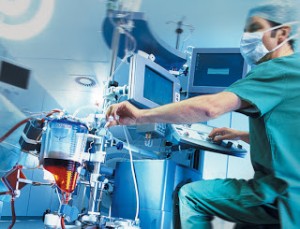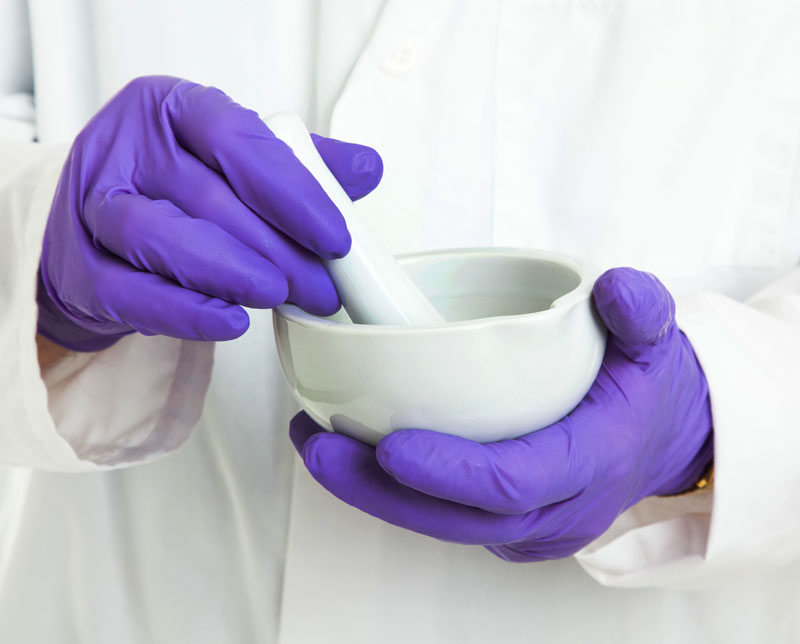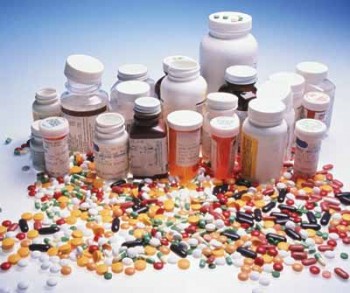favorite day. After filling a couple Pyxis machines on the floor, I was to observe a KIDNEY TRANSPLANT!!! The patient's sister was in the next OR having a kidney removed, while I followed the CRNA as we brought the recipient back to get ready. While the actual surgery primarily involves gross anatomy, the general anesthesia delivers a complex protocol of drugs to ensure that the patient cannot feel, cannot move and cannot remember. The anesthetic process begins in the Pre-Care area as the patient says good-bye to family and friends (and apparently takes pictures with the nurses). While different for different patients and certain surgeries, the general protocol for patient induction includes:
1. Midazolam - the sedative relaxes the patient and is given in the pre-care area. Working almost immediately, the patient is not unconscious but also will not remember anything about heading into the OR.
2. Fentanyl - the narcotic pain killer helps to make sure the patient does not feel anything. This is given after the patient has been transferred to the surgical table.
3. Lidocaine - the local anesthetic prevents the burning sensation upon the administration of the next medication.
4. Propofol - the general anesthetic helps keep the patient unconscious for the entire surgery. It is a milky, white emulsion. If you did not know, propofol was the agent that killed Michael Jackson
5. Succinylcholine - the paralytic makes sure the patient cannot move while the surgeon operates.
 During the actual surgery, the surgeon goes to work opening up the patient. While the kidneys are in the back of your body, the new kidney will be placed in the front. The surgeon must first get through a lot of tissue which involved cauterizing the incisions. I won't soon forget the smell of burning flesh. Once he reaches the kidney, he must disconnect all the pipes to and from the kidney to be refitted for the sister's kidney. Meanwhile, the CRNA continues to monitor the patient's vital signs - adjusting knobs on the ventilator and providing a small electric shock to check for paralysis. Soon the sister's kidney is brought in from next door in a large silver bowl. When the surgeon finishes detaching the original kidney, he moves to a separate table to inspect, clean and prepare the new organ. But when he goes to the other table, the patient is still there. Opened up with clamps and things sticking out of her! Sadly, this was the point that I had to leave to go to a meeting. The surgery would last for another few hours, but I would not be back in time.
During the actual surgery, the surgeon goes to work opening up the patient. While the kidneys are in the back of your body, the new kidney will be placed in the front. The surgeon must first get through a lot of tissue which involved cauterizing the incisions. I won't soon forget the smell of burning flesh. Once he reaches the kidney, he must disconnect all the pipes to and from the kidney to be refitted for the sister's kidney. Meanwhile, the CRNA continues to monitor the patient's vital signs - adjusting knobs on the ventilator and providing a small electric shock to check for paralysis. Soon the sister's kidney is brought in from next door in a large silver bowl. When the surgeon finishes detaching the original kidney, he moves to a separate table to inspect, clean and prepare the new organ. But when he goes to the other table, the patient is still there. Opened up with clamps and things sticking out of her! Sadly, this was the point that I had to leave to go to a meeting. The surgery would last for another few hours, but I would not be back in time. Overall the process of renal transplant was amazing. The amount of drugs pumped into a patient for induction, maintaining, and waking is incredible. I witnessed about 7 or 8 medication, with several on the table in case of emergencies. If anything else was needed, a Pyxis machine was available with a healthy stock of medications. That kind of concerned me. The nurse could grab just about anything, the doctor could order anything at any time. But there was not form of pharmacist verification with any of it. The OR seemed like the Wild West, where the laws of pharmacy were no longer valid. There was a phone to call a pharmacist if there was a question, but it was completely up to the nurse and the surgeon. I am by no means questioning their abilities, but it seemed odd after learning about order verification and other steps to avoid medication errors.
After returning from my meeting, I spent time with the OR pharmacist. They actually rotate from the Inpatient Pharmacy up to the OR on some kind of schedule. Which makes sense, you definitely need someone who knows with IVs in an OR. Strangely, no pharmacists are in the satellite for the evening or night shift. There are technicians, but if something needs to be verified, they must call or travel down to the CIP. When I sat with him, the pharmacist was busy verifying the antibiotics for the next day's operations. When patients prepare
for surgery, they are given a prophylactic administration of antibiotics. The
most important surgical complication comes from post-operative infection.
Different surgical areas must prepare for different types of microbes. Upper
body surgeons are concerned about Gram-positive bacteria like Staph and Strep.
They tend to order ceFAZolin. Lower body and GI surgeons encounter more Gram-negative
bacteria. Interestingly, urologist typically order levofloxacin.
Anyways, he went through the each patient to make sure that the antibiotic
matches up with the type of surgery. Instead of memorizing the antibiotics, UNC
has prepared a list of common orders for every category and other criteria. For
some medicines, the pharmacist must check renal function by calculating CrCl
using a common equation (CrCl=(140-age)/SCr). Levofloxacin and Meropenem were
most commonly ordered and checked for renal function. Gentamycin was much more
difficult to dose as it is based on the patient's ideal weight determined through a complicated equation. The surgeons
commonly only use the patient's actual weight, but the pharmacist must change
the dose. If gentamycin is dosed incorrectly for extended periods, it can
result in ototoxicity (hearing loss).
As you can tell from the length of this post, I really enjoyed this day. I learned a lot from observing the CRNA and sitting with the pharmacist. Who wouldn't enjoy a kidney transplant? To me, the OR seemed like an open opportunity. More than just short staffing problems, but about the verification process of surgical medication. The pharmacist could have more of a role during surgery. They may not need to be in the actual room, but there could be a place for more aggressive involvement. Hospitals perform hundreds of surgeries a day. I feel like the OR could be a possible frontier in the future of pharmacy.
As you can tell from the length of this post, I really enjoyed this day. I learned a lot from observing the CRNA and sitting with the pharmacist. Who wouldn't enjoy a kidney transplant? To me, the OR seemed like an open opportunity. More than just short staffing problems, but about the verification process of surgical medication. The pharmacist could have more of a role during surgery. They may not need to be in the actual room, but there could be a place for more aggressive involvement. Hospitals perform hundreds of surgeries a day. I feel like the OR could be a possible frontier in the future of pharmacy.












